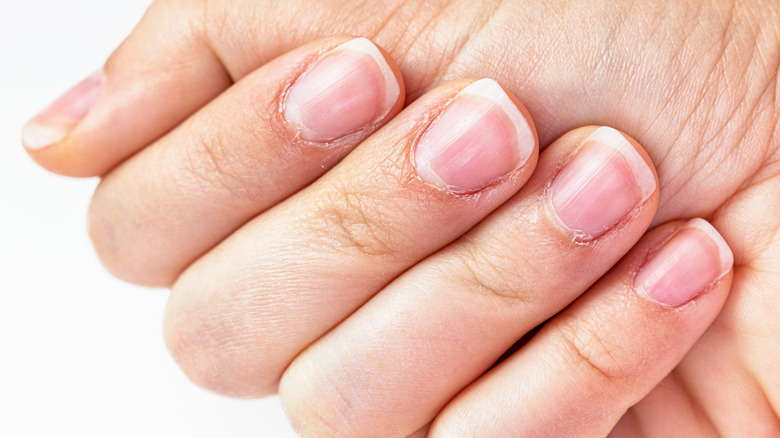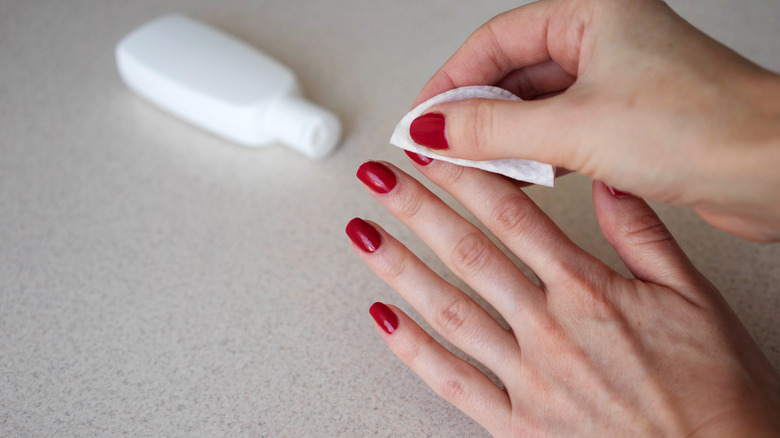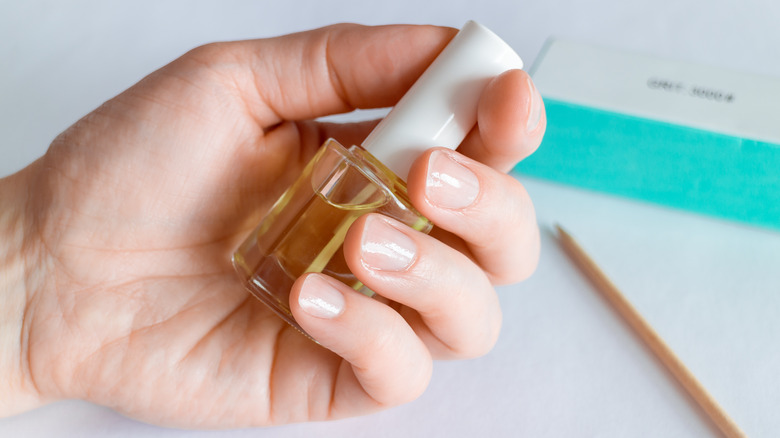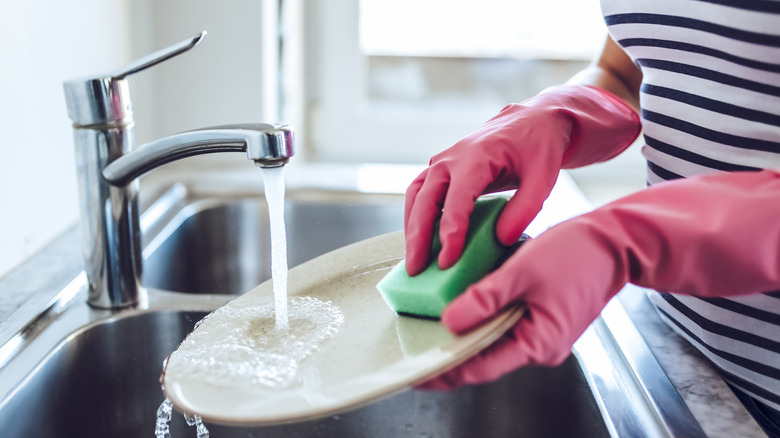If Your Fingernails Are Feeling Weak And Brittle, A Nail Detox Might Be What You Need
During times of increased anxiety, we're more likely to experience acne. Certain rashes indicate food allergies, and dehydration or liver disease can lead to discoloration. What's more, tiny yellow bumps bordering the eyes can be a symptom of high cholesterol. As Philadelphia-based dermatologist Bruce Brod, MD, FAAD confirms for the American Academy of Dermatology Association, "You can tell a lot about somebody by looking at their skin." The same applies to our hair and nails, really any part of our bodies made from the protein keratin.
Considering our nails are a first layer of defense when it comes to protecting the body against germs, it's important to keep them healthy. If your fingernails are feeling weak and brittle from frequent salon visits, a lack of hydration, or even poor nutrition, a nail detox might be what you need. In just a week you should notice a sizable difference. Here's how to get started.
Remove leftover polish and soak your fingers in warm water
If your nails chip regularly or you're beginning to notice discoloration, focus on restoring hydration rather than covering up damage with more polish, specifically gel polish. Those white spots on your nail beds — aka keratin granulation — are a symptom of dehydration. If you want spot-free natural nails, take a break from color.
For starters, use nail polish remover — ideally one that's acetone-free like this jojoba-based product from Ella + Mila — and wipe away any leftover pigment. If you have gel-based or acrylic extensions, remove them with care. Because this process usually involves soaking your faux nails in acetone, aftercare is especially important. Ultimately, it isn't so much the nail polish itself that sucks moisture from the nail bed, it's the harsh removers we use in between colors. As Dr. Bruce Katz, a board-certified dermatologist, recommends to Makeup.com, "Once your nails are clean, restore moisture by soaking your fingers in warm water for 10 to 15 minutes every night." After soaking, you can move on to the next step in the detox.
Try out nail slugging
Next, it's time to start using cuticle oil. Cuticles act as a protective barrier between the base of your nails and potentially harmful bacteria — in other words, healthy cuticles mean healthy regrowth. After soaking your nails in warm water, give the skin surrounding your fingertips some TLC. Let that cuticle oil fully soak in with the help of petroleum jelly or extra-thick hand cream — this viral technique is called "nail slugging," and it can prevent painful ingrowns and restore strength.
In fact, nail slugging has over 3 million views (and counting) on TikTok alone. As Dr. Dana Stern (@drdananails) explains in a quick how-to, exfoliation is an essential, often overlooked part of the process. Whether you start with a homemade sugar scrub or Dr. Dana's nail repair kit, getting rid of dead skin cells before reincorporating healthy oils back into your fingers goes a long way. On top of that, use moisturizers that include glycolic or lactic acid, which can help with exfoliation and regrowth. "It's also great for rough and bumpy skin" internet famous dermatologist Dr. Dray explains to her followers, per TikTok.
Schedule a polish-free week every once and a while
If you're someone who regularly bounces back and forth between colors, painting your nails for everything from national holidays to regular work weeks, make sure to take a break every once and a while. As hair and skincare expert Adina Mahalli recommends in a conversation with Sunday Edit, replace nail polish with a moisturizing routine and a clear nail strengthener. Though most polishes alone won't damage your nails, look out for ingredients like formaldehyde, toluene, and dibutyl phthalate (DBP) on the back of the label — Derma Doctor calls these the toxic trio.
Like polishes, there are some nail strengtheners that also contain harmful chemicals, ingredients that may temporarily protect your nail beds but only damage them in the long run. For starters, check out OPI's nail strengthener. It has over 30,000 five-star ratings on Amazon. For a full week, replace color with a strengthener. Editorial manicurist Jin Soon Choi advises scheduling a polish-free week at least four times a year (via Nylon).
Rethink your diet while you're at it
If your fingernails are soft and bending, certain foods can also help restore strength. For starters, don't underestimate the power of protein. "Because nails are made of the protein keratin, a diet that includes plenty of protein like red meat can help your nails repair, grow and maintain their strength," Dave Crisalli, CEO of PROSE nail boutiques, tells The Food Network. If you're a non-meat eater, nuts, seeds, and (of course) tofu can do the trick. Wild fish and avocados, which contains high levels of Omega-3 fatty acids, help rejuvenate your nails. Raw spinach is a great source of calcium and vitamin A. When in doubt, invest in a hair and nail supplement.
Finally, perhaps most importantly, focus on drinking lots of water. The recommended daily amount for women is approximately 9 cups, some of which you can get from fruits and vegetables with a high water content, according to Harvard T.H. Chan School of Public Health.
Steer clear of environments that can dry out your nails
Ever finished washing a stack of dishes only to find your fingers dry and cracked? You're not alone. Prolonged exposure to water can weaken your nails. As outlined by WebMD, wet nails grow in size. As that moisture evaporates, they shrink. To keep your nails protected long-term, reconsider the way you do your dishes. While you're cleaning up, throw on a pair of sturdy (and stylish) rubber gloves, protecting your nails from damaging changes in size. Certain cleaning products can also harm your nail beds. While you're disinfecting the bathroom or polishing the floors, wear that same pair of rubber gloves.
Keep in mind that weak and brittle nails could be part of a larger puzzle. If your condition doesn't improve after a detox, consult a doctor. Hypothyroidism and anemia can manifest themselves in your hair and nails. In the meantime, trying out a sheet mask for your hands can't hurt — yes, such things do exist.




